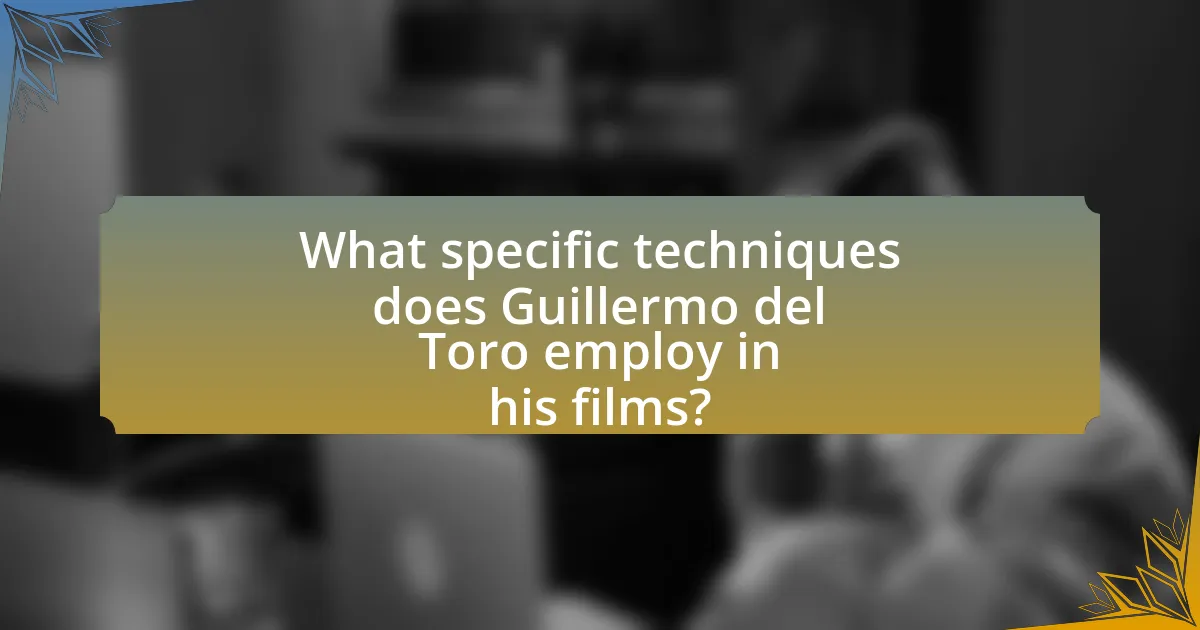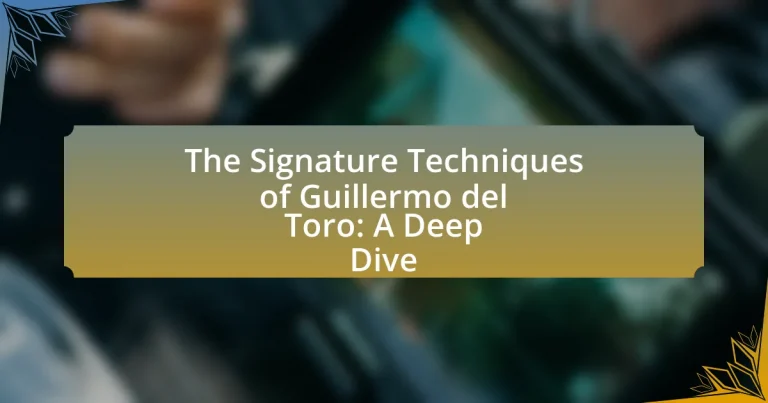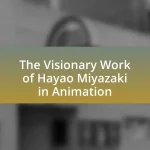Guillermo del Toro is a renowned filmmaker known for his distinctive techniques that blend fantasy and horror with rich visual storytelling. This article explores his signature methods, including the use of practical effects, intricate creature designs, and character-driven narratives that evoke empathy. It delves into the thematic elements prevalent in his work, such as the exploration of innocence, monstrosity, and societal issues, while highlighting how his cultural background and personal experiences shape his artistic vision. Additionally, the article examines his collaborative approach with other artists and the significance of symbolism in his narratives, providing insights for aspiring filmmakers on how to effectively integrate these techniques into their own storytelling.

What are the Signature Techniques of Guillermo del Toro?
Guillermo del Toro’s signature techniques include the use of rich visual storytelling, blending fantasy with horror, and a focus on character-driven narratives. His films often feature intricate creature designs, which he meticulously crafts to evoke empathy and depth, as seen in “Pan’s Labyrinth” and “The Shape of Water.” Del Toro frequently employs practical effects and puppetry, enhancing the tactile quality of his worlds, while his thematic exploration of the outsider and the monstrous reflects his personal experiences and cultural background. These elements combine to create a unique cinematic language that resonates with audiences and critics alike.
How do Guillermo del Toro’s techniques distinguish his films from others?
Guillermo del Toro’s techniques distinguish his films through a unique blend of visual storytelling, rich character development, and thematic depth. His use of practical effects and intricate creature designs, as seen in films like “Pan’s Labyrinth” and “The Shape of Water,” creates a tangible sense of realism that sets his work apart from others in the fantasy genre. Del Toro often incorporates folklore and mythology, infusing his narratives with cultural significance and emotional resonance, which enhances viewer engagement. Additionally, his focus on the duality of human nature and the exploration of marginalized characters adds layers of complexity to his stories, making them not only visually stunning but also thought-provoking.
What thematic elements are prevalent in Guillermo del Toro’s work?
Guillermo del Toro’s work prominently features themes of innocence, monstrosity, and the intersection of fantasy and reality. His narratives often explore the fragility of childhood, as seen in films like “Pan’s Labyrinth,” where a young girl navigates a dark, fantastical world amidst the horrors of war. Del Toro frequently portrays monsters not as mere antagonists but as complex characters that embody human emotions and struggles, exemplified in “The Shape of Water,” where the creature represents love and acceptance. Additionally, his films often delve into the consequences of societal issues, such as oppression and discrimination, reflecting his commitment to social commentary through the lens of fantasy.
How does Guillermo del Toro utilize visual storytelling?
Guillermo del Toro utilizes visual storytelling through meticulous attention to detail, rich color palettes, and symbolic imagery that enhance narrative depth. His films often feature fantastical elements that reflect emotional truths, such as the use of monsters to symbolize inner struggles or societal issues. For instance, in “Pan’s Labyrinth,” the labyrinth itself serves as a visual metaphor for the protagonist’s journey and the complexities of her reality. Del Toro’s signature style includes blending horror with fairy tale aesthetics, creating a unique visual language that resonates with audiences and conveys complex themes without relying solely on dialogue.
What role does fantasy play in Guillermo del Toro’s filmmaking?
Fantasy serves as a crucial narrative and thematic device in Guillermo del Toro’s filmmaking, allowing him to explore complex human emotions and societal issues through imaginative storytelling. Del Toro often uses fantastical elements to create allegories that reflect real-world struggles, such as the loss of innocence, the impact of war, and the nature of monstrosity. For instance, in “Pan’s Labyrinth,” the fantasy world serves as a stark contrast to the brutal realities of post-Civil War Spain, illustrating the protagonist’s escape from trauma. This blending of fantasy and reality not only enriches the narrative but also invites audiences to engage with deeper moral and philosophical questions, demonstrating how del Toro’s unique approach to fantasy is integral to his artistic vision.
How does he blend horror and fantasy in his narratives?
Guillermo del Toro blends horror and fantasy in his narratives by intertwining grotesque elements with whimsical storytelling, creating a unique atmosphere that evokes both fear and wonder. His films often feature fantastical creatures, such as the faun in “Pan’s Labyrinth” and the amphibious man in “The Shape of Water,” which serve as metaphors for deeper human emotions and societal issues. Del Toro’s use of rich visual aesthetics, combined with themes of innocence lost and the struggle against oppressive forces, reinforces this blend. For instance, “Pan’s Labyrinth” juxtaposes the harsh realities of post-Civil War Spain with a dark fairy tale, illustrating how fantasy can emerge from horror. This technique not only captivates audiences but also invites them to explore complex themes within a fantastical context.
What are the recurring motifs in his films?
Recurring motifs in Guillermo del Toro’s films include the exploration of innocence, the juxtaposition of beauty and horror, and the presence of fantastical creatures. Del Toro often portrays children or innocent characters facing dark realities, as seen in “Pan’s Labyrinth” and “The Devil’s Backbone.” He frequently contrasts enchanting visuals with grotesque elements, creating a unique aesthetic that highlights the duality of existence. Additionally, his films often feature mythical beings, such as faeries and monsters, which serve as metaphors for deeper human emotions and societal issues, reinforcing themes of empathy and understanding.
How does Guillermo del Toro’s background influence his techniques?
Guillermo del Toro’s background significantly influences his filmmaking techniques through his childhood experiences and cultural heritage. Growing up in Guadalajara, Mexico, del Toro was immersed in folklore, mythology, and the horror genre, which shaped his narrative style and visual aesthetics. His fascination with monsters and the supernatural is evident in films like “Pan’s Labyrinth” and “The Shape of Water,” where he blends fantasy with emotional depth, reflecting his personal experiences and cultural narratives. Additionally, del Toro’s education in filmmaking and his work in special effects have equipped him with a unique technical skill set that enhances his storytelling, allowing him to create visually stunning and thematically rich films that resonate with audiences globally.
What personal experiences shape his storytelling style?
Guillermo del Toro’s storytelling style is shaped significantly by his childhood experiences, particularly his fascination with monsters and folklore. Growing up in Guadalajara, Mexico, del Toro was influenced by local myths and the rich tapestry of Mexican culture, which instilled in him a deep appreciation for the fantastical and the macabre. His early exposure to horror films and fairy tales, combined with his experiences of feeling like an outsider, informs his narratives that often explore themes of alienation and the human condition. Del Toro’s personal struggles, including his battle with dyslexia, further contribute to his unique visual storytelling approach, emphasizing emotion and atmosphere over traditional narrative structures.
How does his cultural heritage reflect in his films?
Guillermo del Toro’s cultural heritage is prominently reflected in his films through the incorporation of Mexican folklore, mythology, and themes of identity. His works often feature elements such as fantastical creatures and supernatural narratives that draw from traditional Mexican stories, exemplified in films like “Pan’s Labyrinth,” which intertwines historical context with fairy tale motifs. Additionally, del Toro explores themes of marginalization and the struggle for belonging, resonating with his own experiences growing up in Mexico. This cultural backdrop not only enriches the storytelling but also provides a unique lens through which audiences can engage with universal themes of humanity and resilience.
What impact did his childhood influences have on his artistic vision?
Guillermo del Toro’s childhood influences significantly shaped his artistic vision by instilling a fascination with monsters and folklore. Growing up in Guadalajara, Mexico, he was exposed to rich cultural narratives and horror films, which inspired his unique storytelling style. His early experiences with his grandmother, who shared traditional tales, and his passion for classic horror cinema, such as the works of Universal Studios, directly influenced his thematic focus on the intersection of beauty and monstrosity. This foundation is evident in his films, where he often explores complex characters and moral ambiguity, reflecting the duality he perceived in his childhood influences.
How does Guillermo del Toro collaborate with other artists?
Guillermo del Toro collaborates with other artists through a highly interactive and inclusive creative process. He often engages in discussions and brainstorming sessions with visual artists, writers, and designers to develop the aesthetic and narrative elements of his films. For instance, del Toro frequently works with concept artists like Mike Mignola and visual effects teams to ensure that the visual storytelling aligns with his unique vision. His collaboration extends to composers, such as Alexandre Desplat, to create soundscapes that enhance the emotional depth of his narratives. This collaborative approach is evident in films like “Pan’s Labyrinth” and “The Shape of Water,” where the synergy between del Toro and his artistic partners results in a cohesive and immersive cinematic experience.
What is the significance of his partnerships with production designers?
The significance of Guillermo del Toro’s partnerships with production designers lies in their collaborative ability to create visually immersive worlds that enhance storytelling. Del Toro’s distinctive aesthetic, characterized by rich textures and intricate details, is largely realized through these partnerships, as seen in films like “Pan’s Labyrinth” and “The Shape of Water.” His collaboration with production designers such as Eugenio Caballero and Paul Auster has resulted in award-winning designs that not only serve the narrative but also evoke emotional responses from the audience, reinforcing the thematic depth of his films. This synergy between del Toro and his production designers is crucial for translating his imaginative visions into tangible cinematic experiences.
How do his collaborations enhance the visual aesthetics of his films?
Guillermo del Toro’s collaborations significantly enhance the visual aesthetics of his films by bringing together a diverse range of artistic talents that contribute to a cohesive and immersive visual experience. For instance, his partnerships with cinematographers like Guillermo Navarro and Dan Laustsen have resulted in striking visual compositions that blend rich color palettes with intricate lighting techniques, creating a unique atmosphere that is both enchanting and unsettling. Additionally, his collaboration with production designers such as Eugenio Caballero has led to meticulously crafted sets that reflect the thematic depth of his narratives, as seen in films like “Pan’s Labyrinth” and “The Shape of Water.” These collaborations not only elevate the visual storytelling but also reinforce the emotional resonance of the films, making them visually compelling and thematically rich.

What specific techniques does Guillermo del Toro employ in his films?
Guillermo del Toro employs techniques such as practical effects, intricate creature design, and rich visual storytelling in his films. Practical effects are prominently featured in works like “Pan’s Labyrinth,” where he uses physical models and animatronics to create a tangible sense of realism. Intricate creature design is evident in films like “The Shape of Water,” showcasing his collaboration with artists to develop unique, memorable beings that enhance narrative depth. Rich visual storytelling is a hallmark of his style, as seen in “Crimson Peak,” where color palettes and set designs evoke emotional responses and reinforce themes. These techniques collectively contribute to the immersive and fantastical worlds that del Toro is known for.
How does he utilize practical effects versus CGI?
Guillermo del Toro primarily utilizes practical effects to create tangible, immersive environments and characters, while employing CGI to enhance and complement these effects. Del Toro believes that practical effects provide a physical presence that resonates more authentically with audiences, as evidenced in films like “Pan’s Labyrinth,” where animatronics and makeup were used to bring fantastical creatures to life. He strategically integrates CGI to augment scenes that require elements beyond the capabilities of practical effects, such as large-scale visual transformations or complex environments, ensuring that the digital enhancements blend seamlessly with the physical elements. This approach is reflected in his work on “The Shape of Water,” where practical effects were used for the creature design, while CGI was applied to create water effects and other enhancements, maintaining a cohesive visual style.
What are the advantages of practical effects in his storytelling?
Practical effects in Guillermo del Toro’s storytelling enhance realism and emotional engagement. By utilizing tangible, physical effects, del Toro creates a more immersive experience for the audience, allowing them to connect with the narrative on a deeper level. For instance, in films like “Pan’s Labyrinth,” the use of animatronics and makeup effects for creatures fosters a sense of authenticity that CGI often lacks. This approach not only grounds the fantastical elements in reality but also evokes genuine emotional responses, as viewers can see and feel the weight of the physical presence of characters and environments. Additionally, practical effects often lead to more memorable visuals, as they can be uniquely crafted and manipulated in ways that resonate with audiences, contributing to the lasting impact of del Toro’s films.
How does CGI complement his artistic vision?
CGI complements Guillermo del Toro’s artistic vision by enabling the creation of fantastical creatures and immersive worlds that align with his unique storytelling style. Del Toro often blends practical effects with CGI to enhance the emotional depth and visual richness of his narratives, as seen in films like “Pan’s Labyrinth” and “The Shape of Water.” The seamless integration of CGI allows for the realization of his imaginative concepts, such as the intricate designs of the faun and the amphibious man, which would be challenging to achieve through traditional methods alone. This combination not only elevates the visual experience but also deepens the thematic resonance of his work, showcasing the power of technology in serving artistic expression.
What narrative techniques are characteristic of his storytelling?
Guillermo del Toro’s storytelling is characterized by the use of rich visual imagery, blending fantasy with horror, and deep emotional resonance. His narrative techniques often include the incorporation of fairy tale elements, which serve to explore complex themes such as innocence, loss, and the human condition. Del Toro frequently employs non-linear storytelling, allowing for a layered narrative that invites viewers to piece together the story. Additionally, he utilizes strong character development, often focusing on marginalized figures, which enhances the emotional impact of his narratives. These techniques are evident in works like “Pan’s Labyrinth,” where the juxtaposition of a child’s imagination against the backdrop of war illustrates his signature style.
How does he develop complex characters in his films?
Guillermo del Toro develops complex characters in his films through rich backstories, emotional depth, and moral ambiguity. He often crafts characters that embody both light and darkness, allowing audiences to empathize with their struggles and motivations. For instance, in “Pan’s Labyrinth,” the protagonist Ofelia faces harsh realities while navigating a fantastical world, showcasing her innocence and resilience. Del Toro’s use of visual storytelling, combined with intricate dialogue and character arcs, further enhances the complexity of his characters, making them relatable and multifaceted.
What role does symbolism play in his narratives?
Symbolism plays a crucial role in Guillermo del Toro’s narratives by enhancing thematic depth and emotional resonance. His use of symbolic elements, such as creatures and settings, often reflects complex human experiences and societal issues, allowing audiences to engage with the underlying messages on a deeper level. For instance, in “Pan’s Labyrinth,” the labyrinth itself symbolizes the protagonist’s journey between innocence and the harsh realities of war, illustrating the struggle for identity and autonomy amidst chaos. This layered approach to storytelling not only captivates viewers but also invites them to explore the multifaceted nature of the human condition, making symbolism a vital component of del Toro’s cinematic artistry.
What can aspiring filmmakers learn from Guillermo del Toro’s techniques?
Aspiring filmmakers can learn the importance of blending fantasy with reality from Guillermo del Toro’s techniques. His films often feature rich, imaginative worlds that are grounded in emotional truths, allowing audiences to connect deeply with the characters and narratives. For instance, in “Pan’s Labyrinth,” del Toro juxtaposes the harsh realities of post-Civil War Spain with a dark fairy tale, illustrating how fantastical elements can enhance storytelling by reflecting real-life struggles. This technique emphasizes the power of visual storytelling and the emotional resonance that can be achieved through the careful integration of genre elements.


